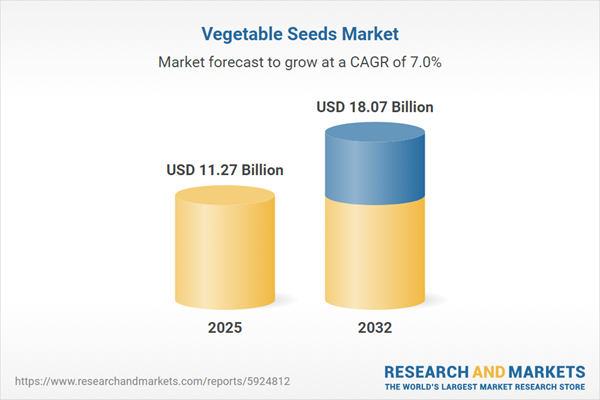Speak directly to the analyst to clarify any post sales queries you may have.
Senior leaders in the vegetable seeds market are navigating rapid innovation, shifting consumer demands, and new supply chain realities. This report delivers targeted insights to empower executive decision-making and organizational agility amid regulatory change and global competition.
Market Snapshot: Vegetable Seeds Market Growth Trajectory
The vegetable seeds market is currently on a steady global growth path, propelled by a strong emphasis on dietary innovation and technological advances in breeding. As nutritional demands evolve, producers are realigning procurement and production to meet new benchmarks. Rapid adaptation and operational flexibility allow organizations to capture shifting opportunities, with leading companies redefining industry standards by introducing advanced breeding processes and responsive strategies. Agility in meeting consumer and partner expectations continues to shape the direction and competitive approach of the top-performing market participants.
Scope & Segmentation of the Vegetable Seeds Market
This report provides in-depth segmentation essential for executive planning and cross-functional strategy. Key segments include:
- Crop Types: Analysis spans cucumbers (covering both pickling and slicing segments), diverse leafy greens such as kale and spinach, a full range of peppers including bell and chili varieties, a wide spectrum of tomato types (such as beefsteak, cherry, heirloom, Brandywine, Roma), root vegetables like beets and carrots, as well as specialized vegetable crops, giving organizations clarity in targeting growth areas across niche and staple sectors.
- Seed Types: Covers hybrid options—including double cross, single cross, and three-way hybrids—alongside open-pollinated varieties, supporting organizations in aligning with dynamic regional growth strategies and responding to production complexities.
- Distribution Channels: Encompasses direct B2B sales, digital sales platforms, specialty retail environments, supply chains serving supermarkets, and wholesale networks for maximized access to distinct buyer groups and enhanced adaptability in market entry planning.
- Application Areas: Includes uses such as contract farming, collaborative ventures with independent growers, garden kit products for retail, and dedicated seeds for research and development—the full spectrum of commercial and R&D-driven applications.
- Seed Treatments: Profiles both treated (fungicide, insecticide) and untreated seeds, with an emphasis on meeting environmental sustainability goals and adhering to variable global regulations.
- Packaging Formats: Examines bulk packaging for industrial-scale use and premium retail-oriented packaging, outlining how these formats enhance logistics efficiency and support brand distinctiveness.
- Regional Markets: Investigates trends and regulatory environments across the Americas, Europe, Asia-Pacific, and the Middle East & Africa, offering regionally tailored analysis of local catalysts and requirements.
- Leading Companies Analyzed: Benchmarks competitive strategies, partnership models, and innovation trends at Bayer AG, Sakata Seed Corporation, Groupe Limagrain SA, Syngenta AG, Rijk Zwaan Zaadteelt en Zaadhandel B.V., Enza Zaden Beheer B.V., East-West Seed International B.V., Takii & Co., Ltd., HM.CLAUSE S.A., and Florimond Desprez SAS to provide actionable leadership insights.
Key Takeaways for Senior Decision-Makers
- Precision agriculture integration and advanced breeding technologies drive greater transparency and robust supply chain resilience across organizations.
- Diversified seed portfolios, balancing both hybrid and open-pollinated varieties, enable rapid response to evolving customer preferences and regional market changes.
- Advanced genetic tools, such as marker-assisted selection and gene editing, provide new routes for tailored crop innovation and product differentiation.
- Focused breeding efforts for nutritionally enhanced crops—particularly in high-demand areas like tomatoes and peppers—allow organizations to capture premium market segments and reinforce downstream value chains.
- Adherence to biotechnology regulations and proactive environmental stewardship encourage continuous governance enhancements and increased supplier scrutiny.
- Diversifying sales channels across digital and conventional models increases organizational agility and operational readiness in diverse market and regulatory scenarios.
Tariff Impact and Supply Chain Dynamics
Amid recent U.S. tariff adjustments, market stakeholders are reevaluating sourcing and logistics strategies. Many leading firms now prioritize distributed production and robust distribution networks, which support compliance and open new opportunities as global regulatory landscapes change. These approaches offer risk mitigation and position organizations for growth in expanding markets.
Methodology & Data Sources
This analysis leverages direct interviews with executives, reviews of established industry literature, and validation by subject-matter experts. This comprehensive triangulation ensures that the report provides senior leaders with practical and timely guidance for navigating sector change.
Why This Report Matters
- Offers segmented market intelligence and benchmarking to inform resilient, adaptable growth strategies in the vegetable seeds sector.
- Clarifies technology, compliance, and operational trends affecting R&D, supply chain management, and regional approaches.
- Supports executive leadership in planning for evolving technological, regulatory, and buyer environments through objective, data-driven insights.
Conclusion
This report provides strategic guidance for executives, supporting innovation, compliance, and robust market positioning in an evolving global vegetable seeds environment.
Additional Product Information:
- Purchase of this report includes 1 year online access with quarterly updates.
- This report can be updated on request. Please contact our Customer Experience team using the Ask a Question widget on our website.
Table of Contents
3. Executive Summary
4. Market Overview
7. Cumulative Impact of Artificial Intelligence 2025
Companies Mentioned
The companies profiled in this Vegetable Seeds market report include:- Bayer AG
- Sakata Seed Corporation
- Groupe Limagrain SA
- Syngenta AG
- Rijk Zwaan Zaadteelt en Zaadhandel B.V.
- Enza Zaden Beheer B.V.
- East-West Seed International B.V.
- Takii & Co., Ltd.
- HM.CLAUSE S.A.
- Florimond Desprez SAS
Table Information
| Report Attribute | Details |
|---|---|
| No. of Pages | 183 |
| Published | November 2025 |
| Forecast Period | 2025 - 2032 |
| Estimated Market Value ( USD | $ 11.27 Billion |
| Forecasted Market Value ( USD | $ 18.07 Billion |
| Compound Annual Growth Rate | 6.9% |
| Regions Covered | Global |
| No. of Companies Mentioned | 11 |









